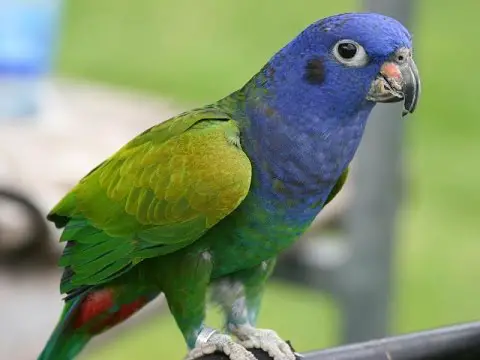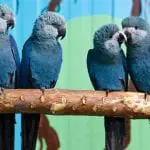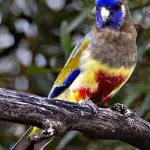Scientific Facts
| Common Name: | Blue-headed Parrot |
| Scientific Name: | Pionus Menstruus |
| Life Span: | 40 years in captivity |
| Size: | 12 inches in length |
| Habitat: | Forests, agricultural areas |
| Country of Origin: | South America and Central America |
Physical Description
Blue-headed parrots can be easygoing, comparably reserved parrots. This makes these birds ideal for people who live in apartments. Having a blazing blue-hint head upon the emerald-green body, these creatures are known to be the most visibly impressive of Pionus parrots normally kept as pets. These birds are normally in medium to large sizes. As they get mature, these birds will normally reach the length of 12 inches if calibrated from the beak to tail. They are comparably sturdy parrots, and adults commonly weigh around 8 to 9 ounces if in a hearty weight.
The upper portions of the wings are bronze overtones. The head is a dazzling and sparkling blue color, and this carries on to the middle section of the breast of the bird. Each cheek has darker and dusty colored circles. The undersides of the tail have red feathers. Also, another unique aspect of these birds is a trait red patch in the beak’s upper mandible.
Young Blue-headed parrots have minimal blue in the head. They have a reddish frontal band. The volume of red feathers greatly differs with individuals. These red feathers commonly fall out once they reach 3 months and are entirely gone by the time they reach 1 year. The blue hue is near to completion at the age of 1 year. Nevertheless, the blue may heighten in concentration until around they reach 2 years. Once these young birds reach 2 to 3 years, they are likely to obtain complete adult coloring.
Lifespan
Just like the other Pionus species and many hookbills, a hearty and properly cared Blue-headed parrot is forecasted to live around 40 years in captivity. Some have even been recorded to live longer than 40 years. Because of their particular long lifespan and the kind of care that is needed when raising a pet bird, promising owners are firmed warned to conduct sufficient research and be certain that they are set to devote to raising and caring a Blue-headed parrot before they proceed with the adoption. Bear in mind that the common reason why Blue-headed parrots die young is either due to poor nutrition or accident. Do not allow your pet to count in. Learn as much as you could to make your pet safe and friendly. Always obey good nutritional habits.
Eating Habits
Blue-headed parrots are commonly good eaters. They commonly feed on seeds, ripe fruits, flowers, and nuts.
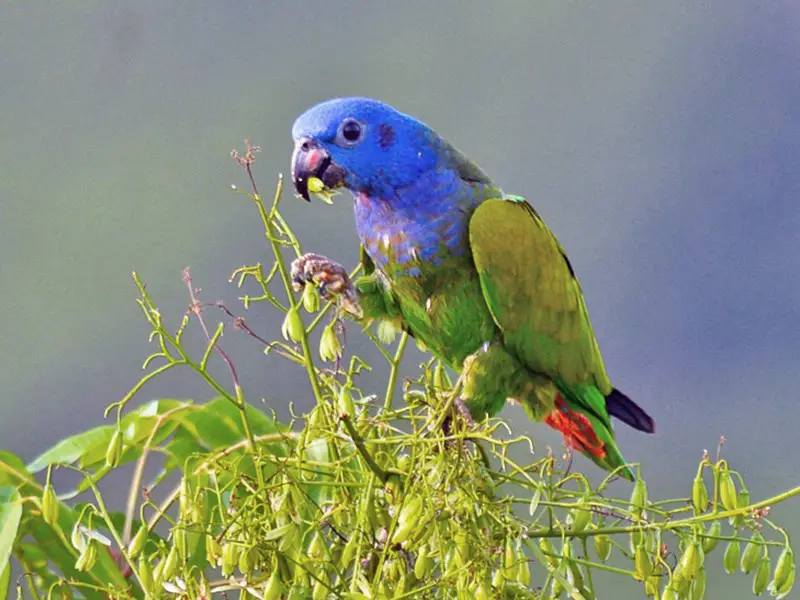
Sleeping Habits
Blue-headed parrots are earlier to bed. You would notice that they would commonly sleep at around 6 or 7 in the evening. These creatures fell asleep easier when the sense of privacy and the surrounding is dark. Many owners would cover the cage of their pets to help them get to sleep.
Development and Reproduction
The season of breeding normally starts in May. In their innate habitat, these birds nest in hollow trees. A typical clutch composes of 3 to 4 white eggs. The incubation period is around 26 days. The immature wean, if they are around 12 weeks old and are commonly sovereign by the age of 3 months. They become mature at the age of 2 to 4 years.
Blue-headed parrots regularly bred in captivity and are averagely hard to breed in captivity. They can be noisy during the season of breeding. If you are near to a neighborhood that is delicate to noise, this should be something to ponder when concluding to breed these birds. Once they reach they are of 3 to 5 years, you will know that they are in their breeding age already. In North America, the season of breeding extends from February or March to June or July.
Blue-headed chicks are confronting to hand-raise. It is recommended that you let the parents take care of the young ones for at least in their first week. Different mealworms and green foods are enjoyed by the parents for nourishing the chicks.
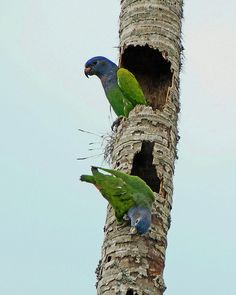
How to Breed
Determining the Sexes
Sexes in Blue-headed parrots cannot be determined visually. Male and female Blue-headed parrots look similar. Determining their sexes is commonly done through surgical sexing or DNA.
Courtship and Mating
During the mating period, Blue-headed parrots live in tree trunk openings, commonly a palm tree, where they are mostly shielded from the elements. Once the male and female Blue-headed parrots breed, the lays produce 2 to 5 white eggs, which hatch approximately 4 weeks later.
During breeding, the male Blue-headed parrot can be assertive towards their mates. One alternative to secure the female Blue-headed parrot is to clip the wings of the male before the breeding season to provide the female the benefit when attempting to break away the assertive male.
Eggs and Incubation
Blue-headed parrots lay 3 to 5 white eggs in tree cavities. At birth, hatchlings are almost bald, not forming many feathers until they reach several weeks old. Chicks are helpless and shall rely on their parents for nourishment, protection, and care until they reach the period of fledging, which is around 10 weeks of age.
Common Health Problems
Aspergillosis
Blue-headed parrots are inclined to Vitamin A deficiency, commonly leading to aspergillosis, a kind of avian respiratory illness, and fungal infections. This illness can manifest the same symptoms as those demonstrated by excited or scared parrots.
Visceral Gout
Blue-headed parrots may also experience visceral gout, which can be related to their diet. If fed with an improper diet, particularly one that is rich in seed, these birds may turn obese.
Preventing Illnesses
Illnesses can be prevented by maintaining a clean aviary or living cage. Blue-headed parrots should be given a balanced diet as well as freshwater. This will stimulate a hearty lifestyle for these birds. However, if you notice something unusual in your pet or if you think that it is showing some indications of illness, it would be best to seek help from a veterinarian.
Behavior
Blue-headed parrots have stature as being an easygoing, silent parrot that can be territorial over the cage. Although these birds are not as snuggly as other kinds of parrots, they can be comparably friendly, particularly if they are raised with appreciative interaction and constant face to face interaction. An anxious Blue-headed parrot may create a perceptible gasping sound, which a handler may misunderstand as a health problem.
These creatures are easily discerned in flight through their strident, loud calls. While resting, the astonishing blue head shows the species explicit. They also have a stature of being self-reliant and at the same time, keeping intimately bonded and committed to their handlers. They love to interact with the family members in the house, doing games, and charming themselves with a lot of bird toys. A lot of owners have said that their birds are laid-back, compassionate characteristics and that they happen to not gnaw as much as other kinds of species – although there is no doubt that Blue-headed parrots are competent in doing so when they take a bent. These birds are also known to be great talkers. Their voice may appear croaky, hence, keep tabs on your bird’s articulations of words you may be missing.
During the season of breeding, they fly in huge flocks and may be observed in the morning flying from the typical breeding venues to their feeding sites. During dawn, a huge quantity of them is observed roosting collectively in the palm and other kinds of trees.
Habitat
Cage
Breeders recommend a cage for a Blue-headed parrot with a dimension of 5 x 1 x 2 meters. Suspended cages help with sanitation as discarded food and droppings fall in the wire cage floor. The cage must provide convenience to the bird. It should have a space that is enough to allow the bird to fully extend its wings.
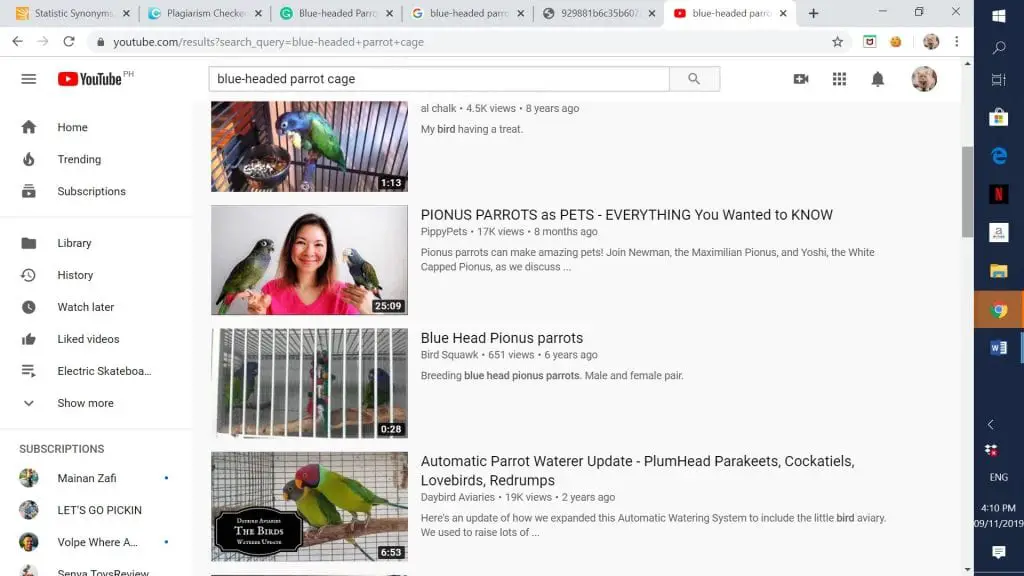
Nest Boxes
Nest boxes do best. A dimension that works best is 25 x 25 x 50 centimeters. Position the nest box in the uppermost in a dark, isolated side of the aviary.
Toys
Blue-headed parrots require toys. These creatures require stimulation. They require entertainment, and they need something that will occupy their time. There are plenty of bird-safe toys available. Remember to consider the size of the toy you are giving. The toy should not be too big or too small; otherwise, it may post danger to your pet. You may secure both foot toys and hanging types.
Diet
Just like the rest of the parrots, sufficient consideration must be given to the nutritional component of the diet of Blue-headed parrots. In captivity, these creatures are likely to do great if they are served with excellent quality commercial pelleted diets, added with a seed mix devised for big birds. These foods must always be given in combination with an array of fresh bird-safe vegetables and fruits to guarantee that they receive a sufficient quantity of vitamins. Blue-headed parrots also commonly enjoy an assortment of homemade bird treats like sprouts, bird bread recipes, and other healthy creations. Pine nuts and peanuts are also enjoyed.
How to Care for Blue-headed Parrot
A Blue-headed parrot that is housed in a very limited cage can become stationary and obese. In caring for your Blue-headed parrot, you should house your pet in a roomy cage and put toys to stimulate it to move around. You should also know that these birds have robust appetites. They should be given a defined primary diet such as superior-quality pellets, incorporated with fresh vegetables and fruits, particularly those that are abundant in Vitamin A because these birds are inclined to Vitamin-A deficiency. It would best to seek advice from an avian veterinarian to know the ideal diet of your pet.
Blue-headed parrots are very dynamic, and they require plenty of space to exercise and play daily. With that being said, people who are planning to get a Blue-headed parrot should be certain that they can allocate at least 3 to 4 hours for their pet to spend outside the cage. Playtime done outside the cage must be rigidly monitored and must be done in a bird-proof place because these birds are very inquisitive and may get harm if left unsupervised.
Even though these birds are not as dazzling as other parrots, novices are welcomed to raise them as pets provided that they are equipped with commitment and patience. Training should be subtle. Never rush your pet to learn tricks. These parrots can become docile if gently handled.
Where to Get?
Blue-headed parrots are widely available. You can get these birds from any avian-specialty stores. You may also find these interesting pets from bird breeders. They are also sometimes obtainable for adoption from some avian-rescue organizations. If you want to be certain with your choice of Blue-headed parrot, make sure to get one from a reliable seller. Remember that these birds will make great pets; thus, many would market them to pet lovers. However, not all of these sellers are honest enough to sell healthy and quality birds.
FAQ Section
I have no experience raising a Blue-headed parrot, but I am planning to get one – will a beginner like me can raise it successfully?
Although Blue-headed parrots are known to be captivating and laid-back, raising it wouldn’t be easy, especially for a beginner like you. If you intend to get one, make sure to do a lot of research to assess whether your lifestyle is fitted to raising a Blue-headed parrot. You may consider contacting a local breeder or reaching out to an aviculture society and talk to people who have direct experience in raising these birds. They can give you reliable guides and information that can help you finalize your decision.
Can Blue-headed parrots talk?
Although Blue-headed parrots are known to have poor talking ability, they are still considered to be the best talkers in the family of Pionus.
Can I allow my child to interact with our Blue-headed parrot?
Yes. Blue-headed parrots are charming and friendly. They will make a great company for kids. However, it is always recommended that there should be an adult supervising during the time your child is playing with your pet.

